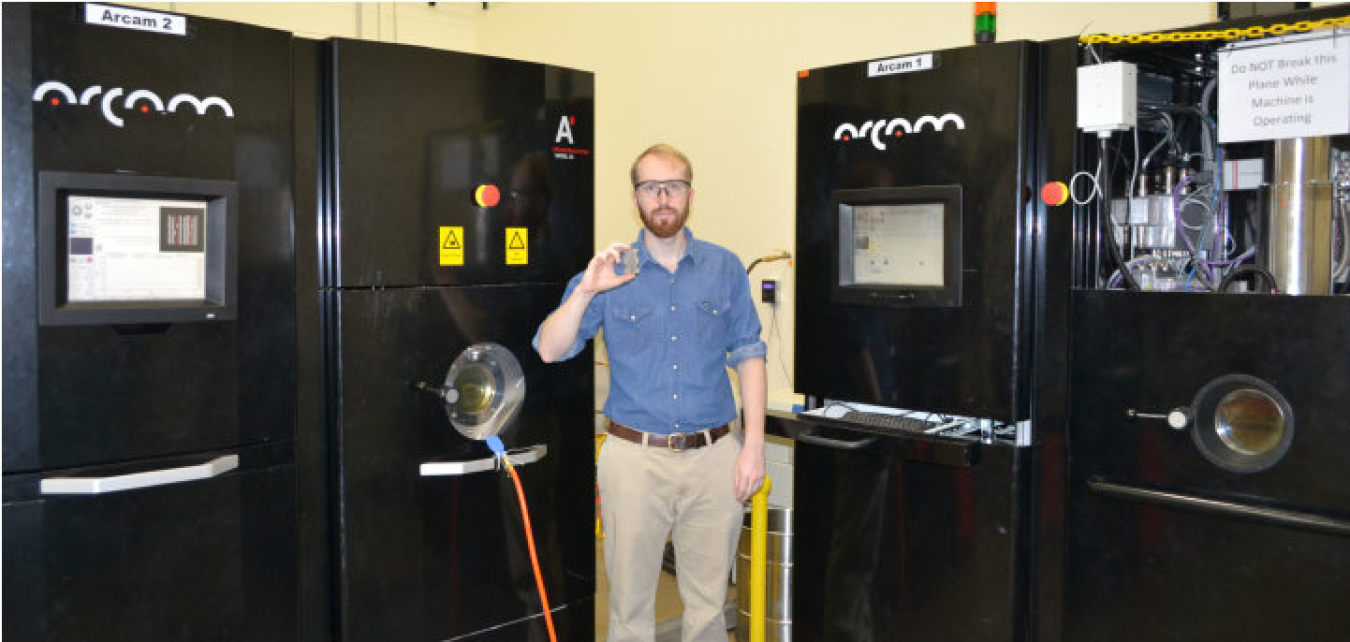Name: William Sames; Institution: Texas A&M University; Program: Integrated University Program (IUP); Education Level: Graduate Student
August 16, 2022As CEO of a company involved in additive manufacturing and diffusion bonding, William Sames recognizes he’s traveled a different road from most PhD researchers who’ve received help from the Department of Energy’s Integrated University Program (IUP). What’s most striking, however, is the path of commerce has gone full circle, back to his nuclear roots. “I went into business,” said Sames, who heads HTS International Corporation (IC). “Commercializing technology is a challenge I like."

William Sames holding Inconel 718 fabricated by Arcam EBM® electron beam melting additive manufacturing, standing next to the machines at the ORNL MDF, where the DOE IUP-funded research was completed.
The Department of Energy invested in our education as IUP Fellows. It is our duty to work hard to give our country a return on investment. For me, that means trying to do the hard things like commercialize technology and create technology-based jobs that didn't exist before.
HTS IC operates sales and research and development (R&D) for HTS IC d.o.o. of Slovenia and provides engineered thermal management solutions for tooling components in the injection molding and die casting industries.
Today, after doing business with automotive, packaging, and medical device manufacturers, Sames and his company are manufacturing vessel components for Oak Ridge National Laboratory’s (ORNL) Transformational Challenge Reactor (TCR), a program to dramatically change how reactors are designed and constructed.
Sames received both an IUP Scholarship while an undergraduate at Texas A&M University, and an IUP Fellowship in 2012 to pursue his doctorate in nuclear engineering. In 2009, the undergraduate scholarship afforded him the freedom to be patient. “I was able to wait for the right research job on campus,” he said. “It gave me some flexibility to get involved with the research I wanted to do.”
As for the fellowship, it wasn’t a sure bet. His application was initially passed over, and he had gone to an internship with Westinghouse’s Nuclear Fuels Group in Pennsylvania when he got word that someone had dropped out and it was available after all.
“I had a plan for what I wanted to do with it,” he said. His dissertation research focused on the development of Inconel Alloy 718 as a production material for use in the Arcam EBM® electron beam melting additive manufacturing process. Inconel 718 is a high-strength, corrosion-resistant nickel chromium material that can be readily fabricated.
Sames said he had an ally at Texas A&M in Sean McDevitt, director of the Nuclear Science Center and head of the university’s materials group. “He was very supportive of me,” he said. As he became more focused on metal additive manufacturing, IUP funding gave him the freedom to explore what resources were available within DOE’s national lab system. In 2011, the possibilities of 3D printing were only starting to be realized. With IUP funding in hand, Sames reached out to ORNL and Ryan DeHoff, the laboratory’s metal additive manufacturing lead in the Manufacturing Demonstration Facility (MDF). Sames became a visiting research fellow at MDF, which allowed him to gain extensive metallurgy training and improve his professional network.
After earning his doctorate in 2015, Sames founded Additerra, a small company in Knoxville focused on additive manufacturing with metals and polymers. The following year he became CEO of HTS IC.
He maintained his ties with ORNL, as HTS IC and the national laboratory signed an agreement to collaborate on advanced manufacturing research in 2017. This was when HTS IC was preparing to launch a series of products under its iTherm® brand. Establishing a collaboration with ORNL to test and validate the iTherm® tool plates and inserts was the first step toward the standardization of conformal cooling for the injection molding industry. Through the collaboration, HTS IC managed to cut molding cycle times by more than 50%, enabling parts to be produced at twice the usual rate and eliminating scrap that can be caused by uneven temperature distribution, polymer warpage, casting porosity, and soldering.
Participating on the TCR project was a career moment for me. I started my studies in nuclear engineering and then researched metal additive manufacturing at the ORNL Manufacturing Demonstration Facility during my IUP Fellowship. Bringing HTS IC’s novel technology to the project felt like coming fullcircle in my career as this is just the start of the synergy between advanced manufacturing processes and the development of next generation small and microreactors.
Using diffusion bonding to fabricate heat exchangers offers strength far superior to brazing. “It has no weak areas,” Sames said. “The bond is no longer the weak point. Instead, it’s the material. You can make very big pieces, and to me that is very exciting.”
HTS IC’s involvement with the TCR project began in 2019, when the company won the opportunity to manufacture vessel components with advanced additive manufacturing technology. In addition to fabricating complex fluid passageways for reactor coolant, the work involves embedding sensors and thermal insulation.
With the COVID-19 pandemic affecting HTS IC’s sales to the automotive sector, TCR also has proved to be something of a lifeline. “We have been able to refocus on other R&D projects as a business,” Sames said.
Although he recognizes that many of his PhD peers are more comfortable at universities and in laboratories, as a person in business, Sames would like to see more people with his mindset take advantage of the Nuclear Energy University Program and IUP Scholarships and Fellowships. “DOE invested in us, in our education as IUP Fellows,” he said. “It is our duty to work hard to give our country a return on investment. For me, that means trying to do the hard things, commercializing technology, and creating technology-based jobs that didn’t exist before.
“I see both ends of it,” he said. “I think these programs are so important. I want to see things that get the best and the brightest out into industry.”

